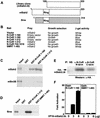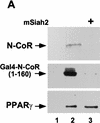Proteasomal regulation of nuclear receptor corepressor-mediated repression
- PMID: 9637679
- PMCID: PMC316907
- DOI: 10.1101/gad.12.12.1775
Proteasomal regulation of nuclear receptor corepressor-mediated repression
Abstract
Repression of gene transcription is a fundamental property of nuclear hormone receptors. We report here that cell-specific repression by nuclear receptors correlates with levels of nuclear receptor corepressor (N-CoR) protein. N-CoR protein levels are regulated by mSiah2, a mammalian homolog of Drosophila Seven in absentia that targets N-CoR for proteasomal degradation. mSiah2 expression is cell-type specific and differentially regulates the repressive activities of nuclear receptors. These findings establish targeted proteolysis of transcriptional coregulators as a mechanism for cell-specific regulation of gene transcription.
Figures









Similar articles
-
Estrogen down-regulation of the corepressor N-CoR: mechanism and implications for estrogen derepression of N-CoR-regulated genes.Proc Natl Acad Sci U S A. 2005 Sep 13;102(37):13153-7. doi: 10.1073/pnas.0502782102. Epub 2005 Sep 1. Proc Natl Acad Sci U S A. 2005. PMID: 16141343 Free PMC article.
-
TBLR1 regulates the expression of nuclear hormone receptor co-repressors.BMC Cell Biol. 2006 Aug 7;7:31. doi: 10.1186/1471-2121-7-31. BMC Cell Biol. 2006. PMID: 16893456 Free PMC article.
-
Differential effects of nuclear receptor corepressor (N-CoR) expression levels on retinoic acid receptor-mediated repression support the existence of dynamically regulated corepressor complexes.Mol Endocrinol. 1997 Jun;11(6):682-92. doi: 10.1210/mend.11.6.0018. Mol Endocrinol. 1997. PMID: 9171232
-
N-CoR-HDAC corepressor complexes: roles in transcriptional regulation by nuclear hormone receptors.Curr Top Microbiol Immunol. 2003;274:237-68. doi: 10.1007/978-3-642-55747-7_9. Curr Top Microbiol Immunol. 2003. PMID: 12596910 Review.
-
Urban renewal in the nucleus: is protein turnover by proteasomes absolutely required for nuclear receptor-regulated transcription?Mol Endocrinol. 2004 Mar;18(3):493-9. doi: 10.1210/me.2003-0388. Epub 2003 Dec 12. Mol Endocrinol. 2004. PMID: 14673136 Review.
Cited by
-
Role of chaperones in nuclear translocation and transactivation of steroid receptors.Endocrine. 2001 Mar;14(2):143-9. doi: 10.1385/ENDO:14:2:143. Endocrine. 2001. PMID: 11394630 Review.
-
The ubiquitin ligase Siah2 regulates obesity-induced adipose tissue inflammation.Obesity (Silver Spring). 2015 Nov;23(11):2223-32. doi: 10.1002/oby.21220. Epub 2015 Sep 18. Obesity (Silver Spring). 2015. PMID: 26380945 Free PMC article.
-
Domain structure of the NRIF3 family of coregulators suggests potential dual roles in transcriptional regulation.Mol Cell Biol. 2001 Dec;21(24):8371-84. doi: 10.1128/MCB.21.24.8371-8384.2001. Mol Cell Biol. 2001. PMID: 11713274 Free PMC article.
-
Involvement of seven in absentia homolog-1 in ethanol-induced apoptosis in neural crest cells.Neurotoxicol Teratol. 2014 Nov-Dec;46:26-31. doi: 10.1016/j.ntt.2014.08.006. Epub 2014 Sep 3. Neurotoxicol Teratol. 2014. PMID: 25193017 Free PMC article.
-
Phyllopod acts as an adaptor protein to link the sina ubiquitin ligase to the substrate protein tramtrack.Mol Cell Biol. 2002 Oct;22(19):6854-65. doi: 10.1128/MCB.22.19.6854-6865.2002. Mol Cell Biol. 2002. PMID: 12215542 Free PMC article.
References
-
- Alland L, Muhle R, Hou H, Potes J, Chin L, Schreiber-Agus N, DePinho RA. Role for N-CoR and histone deacetylase in Sin3-mediated transcriptional repression. Nature. 1997;387:49–55. - PubMed
-
- Carthew RW, Rubin GM. seven in absentia, a gene required for specification of R7 cell fate in the Drosophila eye. Cell. 1990;63:561–577. - PubMed
-
- Chang HC, Solomon NM, Wassarman DA, Karim FD, Therrien M, Rubin GM, Wolff T. phyllopod functions in the fate determination of a subset of photoreceptors in Drosophila. Cell. 1995;80:463–472. - PubMed
-
- Chen JD, Evans RM. A transcriptional co-repressor that interacts with nuclear hormone receptors. Nature. 1995;377:454–457. - PubMed
Publication types
MeSH terms
Substances
Grants and funding
LinkOut - more resources
Full Text Sources
Molecular Biology Databases
Research Materials
